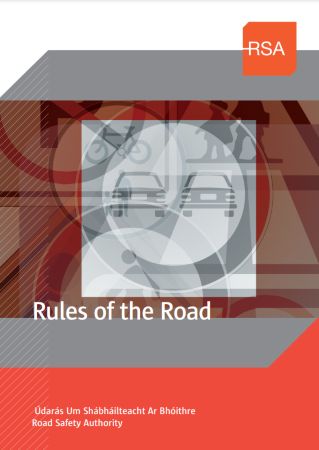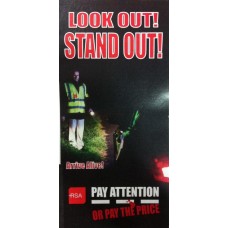Road Users
Road safety advice and guidance for all road users, from pedestrians to professional drivers.
Main road users
Road safety advice and guidance for all road users, from pedestrians, horse riders and cyclists to car drivers, professional drivers and tractor drivers.
Other Road Users
Useful links and information for other road users.
Vehicle standards and FAQs for special purpose vehicles, including motorhomes, ride-on lawnmowers, motorised wheelchairs, hearses.
Vehicle standards for vintage vehicles including private and commercial cars, tractors and motorhomes. Registration and roadworthiness testing. 30-year rule.
Safety advice for horse riders and those leading horses and other animals on the road, as well as drivers meeting horses and animals and transporting dogs or other pets.
Advice for tourists driving in Ireland. Driving on the left, speed limits, seat belts, drink driving, driving licence, caravans, equipment and penalty points.
Support Organisations for those affected by road traffic collisions.
Frequently Asked Questions
Explore the full range of the most popular questions you have been asking RSA teams about road safety.
Explore all FAQPractice these road safety tips whenever you walk, take exercise or head out socially.
- If there is a footpath, you must use it.
- If there is no footpath, you must walk as near as possible to the right-hand side of the road, facing oncoming traffic.
- If the road is narrow or carries heavy traffic, you should walk in single file and never more than two abreast.
- You should always wear bright, high-visibility clothing when walking during the day and reflective clothing when walking at night.
- You should always carry a torch when walking at night.
- You should always be aware of other road users.
- If you are walking as a group of more than 20 people, you should walk on the left-hand side of the road, in the direction of traffic flow.
- You should never walk on the road after consuming alcohol as this is very dangerous at any time of day or night.
- Before you go out socially, you should always arrange how to get home safely.
Follow our dos and don'ts to make sure you cross the road safely.
| Do's | Dont's |
| Do look for a safe place to cross | Don't cross at a corner or bend in the road |
| Do stop and wait near the edge of the path, or edge of the road if there is no path | Don't cross near the brow of a hill |
| Do look right and left and listen for traffic | Don't cross near parked vehicles |
| Do let any traffic coming in either direction pass, then look right and left again | Don't cross where there are guard rails along a footpath |
| Do walk briskly straight across the road when it is clear | Don't hold or climb onto moving vehicles |
| Do continue to watch and listen for traffic while you cross. | Don't run across the road. |
You should use the following places to cross the road safely:
Zebra crossing
/people-crossing-the-road.jpg?Status=Master&sfvrsn=1fa684b9_3)
Things to know before you use a zebra crossing:
- You do not have right-of-way over traffic until you step onto a crossing. However, you must never step onto a crossing in such a way as to cause a driver to brake or swerve suddenly.
- Drivers should stop to let you cross by slowing down as they approach the crossing, and then stop behind the stop line if there is one.
- You must not cross within the area either side of the crossing marked by zig-zag white lines. If these lines are not provided, you must not cross within an area 15m either side of the crossing.
To cross safely at a zebra crossing:
- You must always watch carefully for approaching traffic.
- You must place one foot on the crossing to indicate that you wish to cross.
- You must wait until traffic has stopped before you start crossing.
- Where there is a central island, you must treat each side as a separate crossing.
Pedestrian lights
/pedestrian-crossing3ef6a964-b088-45f5-a662-8ee02686ee64.jpg?Status=Master&sfvrsn=ceb21352_3)
To cross safely at pedestrian lights:
- You must press the button and wait for the traffic lights to turn red.
- You must not cross while the 'wait' or 'red man' light signal is showing.
- You must cross with care only when the 'cross now' or 'green man' light signal is showing.
- Where there is a central island, you must treat each side as a separate crossing. by waiting for the 'green man' or 'cross now' light signal on each set of lights.
- If you are vision-impaired, an audible bleep signal or a vibrating panel on the push button may be in place to indicate it is safe for you to cross.
Pelican crossing
There are two main signals you should look out for when crossing the road at a pelican crossing. You have priority as a pedestrian when:
- You see an amber traffic light flashing for a short period after the red light for drivers goes out.
- Your 'green man' pedestrian light signal flashes for a short time before changing to the 'red man' signal.
Traffic lights
/unguarded-crossing.jpg?Status=Master&sfvrsn=65007d6_1)
There are a few safety rules you must follow to help you cross safely at traffic lights:
- If you are crossing where there are no light signals for pedestrians, check the lights in both directions.
- When the traffic on the road you wish to cross is governed by a red light, cross with care since the lights can quickly turn green for traffic.
- Always look out for traffic that might be turning onto the road you wish to cross.
- Be aware of multi-flow traffic signals at intersections where traffic lights allow traffic to proceed in some lanes while other lanes are stopped.
- Be especially careful at junctions with filter lanes.
Uncontrolled crossing places
Generally, uncontrolled crossing places or courtesy crossings are designated shared areas of road. They are usually coloured, slightly raised, patterned or cobbled sections of road. You should be aware of the potential dangers when approaching or crossing them.
/street-crossing.jpg?Status=Master&sfvrsn=1ab019e6_1)
To help you cross safely on these crossings:
- Always remember that you do not have an automatic right-of-way.
- You need to be alert that traffic may suddenly approach from either direction.
- You should only enter when you are sure that all traffic is aware of your presence.
Remember, if you can't see the driver, they can't see you.
School Wardens
Adult school wardens carry a special ‘STOP’ sign and are allowed by law to stop traffic.
/road-safety-school-crossing.jpg?Status=Master&sfvrsn=e4a0e0af_3)
To cross safely at a school warden crossing you and your children should:
- Wait until the school warden raises their 'STOP' sign and traffic remains stopped.
- Cross the road walking briskly, but not running, while looking in both directions.
- Never cross the road if the warden has their ‘STOP’ sign lowered or is standing at the footpath.
Take care if you're crossing a road where there is a bus lane, cycle lane or tram track. Especially if they're travelling in an opposite direction to the general traffic flow. You should also be extra careful when getting on or off buses and when crossing the road at or near bus stops.
Remember, never cross in front of a stopped bus.
Wearing reflective armbands, high-visibility belts or vests and other reflective or fluorescent clothing will help you to be seen from a distance, especially at night.
/rsa-vests.jpg?Status=Master&sfvrsn=f84946f4_1)
We offer high-visibility materials to anyone who wants some.
Our research shows that children do not have the ability to safely interact with traffic until they are 12 years old. Before this age, their judgement skills and perception of speed and distance haven’t fully developed. This is why they need the help of an adult to safely walk on and cross the road.
Find more information on getting children to school safely.
If you are sharing a path with cyclists, you should always be mindful of their presence. Paths are usually marked with lines to separate you from cyclists – but not always. Be vigilant at all times for everyone’s safety.
Here are some simple rules you should follow:
- Cyclists are generally travelling at a faster speed than you, so do everything you can to avoid collisions that could cause injury to you both.
- If you are using a footpath with clearly marked cycle and pedestrian lanes, only walk in your designated lane.
- If you are on a footpath with dual markings to show that you are sharing the path with cyclists, watch out and listen carefully as cyclists can often approach you from behind.
Rules of the Road
Rules of the Road includes tips and advice on staying safe on our roads.

Pedestrian road safety campaigns
We have run many pedestrian road safety campaigns to help you stay safe on Irish roads.
Learning from our road safety videos will help keep you and others safe on our roads.
Pedestrian leaflet

Order and read Look Out Stand Out our pedestrian safety leaflet.

-450-x-242-px/cyclists-on-country-road.jpg)
/pedestrian-safety-walking.jpg)
/legislation.jpg)

-450-x-242-px/motorcyclist.jpg)
-450-x-242-px/vehicle-truck-safety-inspection.jpg)
-450-x-242-px/agricultural-vehicle.jpg)

/pedestrians-crossing-road.jpg?Status=Master&sfvrsn=706a3c77_3)